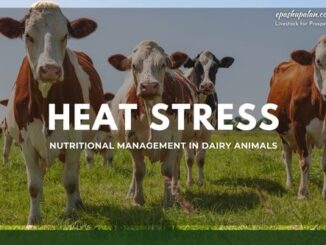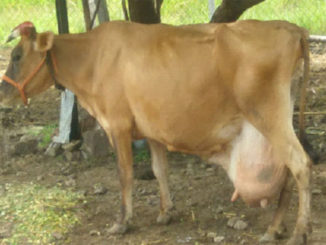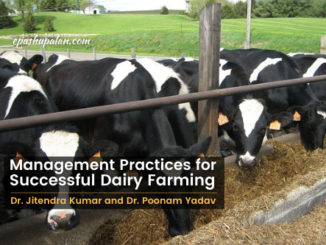Abstract
Environmental heat stress is obviously the problem faced by the animals located in hotter (tropical) regions of the world. Heat stress not only reduces milk yield in cows and buffaloes but also affects several other economic parameters viz. animal health and animal reproduction, resulting in a significant economic impact on the dairy owners in these countries. The most obvious effect of heat stress is the reduction in feed intake, leading to a decrease in milk yield. But apart from that, there are several other metabolic implications that also contribute to the reduction in milk yield. In addition to that, there is a decrease in milk quality, primarily due to an increase in somatic cell count (SCC) and incidence in mastitis, increased health care cost, and reduced growth in heifers. However, to overcome the challenge of environmental heat stress in tropical countries on dairy animals, some management and nutritional strategies have been worked out by several researchers, which may help, but only partially.
Key Words: Heat Stress, Economic Parameters, Somatic Cell Count (SCC), Environment

Adaptations to Dry and Hot Climate
An excellent example of an animal adapted to an extremely hot and dry climate is no doubt the camel, a pseudo-ruminant. Not only has this animal an ability to be comfortable in such a climate, but it can do without food and water for many days. The fat stored in its hump comes to its rescue, slowly releases energy, even at 10 days of starvation.
Ruminants, however, are devoid of such an efficient adaptive mechanism and can fight heat stress to a limited extent only. However, the ability to fight heat stress varies among ruminant species and breeds, depending upon whether evolved in temperate or tropical regions. The Bos indicus too has fat stored in its hump, which helps the animal to use the stored energy during its limited nutrient supply. These animals are in a better position to dissipate heat during the hot season, unlike Bos Taurus, with no hump and the fat evenly spread subcutaneously, which makes the thermo-regulation and heat dissipation difficult during the hot season.
Adaptations to Hot and Humid Climate
The hot humid conditions are the most stressful for the animals. The best-adapted animal for the humid tropics is undoubtedly the buffalo. Although its sweat glands are far less active than the zebu cattle, however, the wallowing helps it a lot to get rid of the body heat. So, it definitely needs water or mud to assist it in thermo-regulation.
Temperature Humidity Index (THI)
A Better Predictor of Heat Stress: A combination of the two variables, temperature-humidity index; THI is a better predictor of whether or not cows are “stressed”. A THI < 72 is the point at which a dairy cow starts to decrease productivity.
Adaptation to Inferior Quality Feeds
It can be generally said that roughages and grasses in tropical regions are of lower quality than in temperate regions. The major roughages available for bovine feeding in tropical regions are straw, Stover, and other crop residues, characterized by lower palatability, lower digestibility and low nutrient content in terms of energy, proteins, minerals and vitamins. However, cattle breeds in tropics are often adapted to these inferior feeds by having a higher rumen volume relative to body weight, enabling them to have longer retention time in the rumen to digest it relatively more. Buffaloes are more suited to these conditions, as apart from higher rumen volume and longer retention time, they also perform better on fibrous diets, possessing higher digestive ability to utilize fiber, than cattle.
Heat Stress Reduces Feed Intake/ Quantity of Milk Produced
Unabated heat stress can decrease feed intake by more than 35%. However, even in well-cooled dairies decrease in feed intake due to heat stress may be between 15-20 %. In non-cooled management systems, milk yield can decrease by 40-50 % during severe conditions. Reduction in feed intake due to heat stress reduces consequently nutrient intake, resulting in decreased milk synthesis in the mammary gland. However, the reduction in milk production is not just due to a reduction in feed intake only, but due to heat stress itself.
Reason for Reduced in Feed Intake
About 40% of the energy from Volatile fatty acids (VFA) produced in rumen and then absorbed from rumen, are used as energy spent on heat dissipation. Another 10 % of energy is spent on eating, chewing, and propulsion of roughages through the gut. In hot climates, as the animals are unable to cope up with the dissipation of heat, there is a signal from the central nervous system to limit feed intake, so as to avoid extra heat load. This is the main cause of the reduction in feed intake in heat-stressed animals. Ironically, though heat stress reduces feed intake, the animal actually needs more energy even to fight heat stress through the process of heat dissipation (just like air conditioning mechanism).
Under thermo-neutral condition, the energy required for milk synthesis is partly met from the tissue mobilization through the phenomena of nutrient partitioning. However, in cows subjected to heat stress, nutrient supply to the mammary gland are limited by the double effect of reduced feed intake as well as restricted tissue mobilization, resulting in lower milk synthesis in the mammary gland.
Post-Absorptive Metabolism of Heat Stressed Cows
The post-absorptive metabolism of heat-stressed cows markedly differs from that of thermal neutral cows, more so that of lactating cows. This is due to the metabolic adaptations that animals undergo, in order to deal with heat stress. This becomes a metabolic priority even in dairy animals, for which generally the first priority happens to be the mammary gland.
The physiological mechanism by which heat stress impacts production and reproduction include reduced feed intake, altered endocrine status, reduction in rumination and nutrient absorption, and increased maintenance requirements, resulting in a net decrease in nutrient availability for production. Reductions in energy intake during heat stress results in a majority of lactating cows entering into negative energy balance (NEBAL).
- Heat-Stressed Cows are Susceptible to Rumen Acidosis: Heat stress forces cows to dissipate heat via panting, leading to increased respiration rate and the enhanced rate at which CO2 is exhaled out. This leads to the decreased blood CO2 level, which is made up by converting part of HCO3 (Bicarbonate) secreted by the liver to CO2. The result is that rumen gets less bicarbonate through saliva for buffering activity than it actually requires maintaining its pH, making the animal more susceptible to sub-clinical and acute rumen acidosis. The unhealthy rumen environment causes a reduction in feed intake and also may lead to laminitis and milk fat depression, etc.
- Switching Metabolism to Prevent Adipose Mobilization/ FA Oxidation: Early lactation cow is a classic example of lactation-induced negative energy balance (NEBAL). When the cow is in thermo-neutral condition, even if the feed intake is not matching with the nutrient demands of the mammary gland, reduced insulin levels and enhanced growth hormone levels partition the nutrients in favor of milk synthesis. This allows mobilization of adipose fat, transported to the mammary gland as Non-Esterifies Fatty Acids (NEFA), and serving as a precursor for fat synthesis in the mammary gland. However, unlike NEBAL in thermo-neutral conditions, heat-stressed induced NEBAL does not result in elevated plasma NEFA level, because heat stress blocks fat breakdown.
- Switching Metabolism to Step-up Glucose Production: Gluconeogenesis in the liver is at its peak in early lactation cows, to meet the demands of the mammary gland for lactose synthesis. During heat stress, though there is more glucose production than under thermo-neutral conditions, a good proportion of this glucose is required to provide energy at the tissue level. This is a metabolic adaptation by the animal to fight heat stress so that less metabolic heat is generated. That is why in heat-stressed cows, the glucose disposal rate is much higher than in cows in thermo-neutral conditions. Thus, the reduced feed intake coupled with reduced availability of glucose (than its actual production) to the mammary gland for lactose synthesis, results in a significant decrease in milk synthesis/ yield in heat-stressed cows.
- Reduced Body Protein Retention/ Increased Muscle Breakdown: The reduced body protein retention is also supported by a decrease in milk protein, including the decrease in the synthesis of alpha and beta-casein fractions of milk from heat-stressed cows. This is because these animals have an increased amino acid need for non-productive functions, primarily to provide energy at tissue level, using amino acids as a precursor for glucose synthesis.
- Cows are more Prone to Impaired Immune Response: The heat stress affects the immune function in cows. Thus, during summer months cows are more prone to metabolic, reproductive, and other health disorders: like mastitis, retained placenta, metritis, and ketosis.
- How to Reduce the Adverse Effect of Heat Stress in Dairy Cows
It has been proved through research that only 40 % of the decrease in milk production is due to reduced DM intake, the rest of the 60 % reduction in milk production can be explained by heat-stressed induced other biochemical changes. However, the adverse effect of heat stress on the overall health and productivity of dairy animals can be overcome to some extent by improving microenvironment and feed management. Following the approaches as given under:
Providing Shelter/ Cooling System
Under Indian conditions, the heat stress can be reduced somewhat by providing proper shelter, controlling air moments and causing a cooling effect inside with the combination of mist cooling and fan. This is being adopted by many big dairy farmers in India. Of course, the effect of heat stress on milk production can only be partially reduced.
Reducing the Quantity of Fibrous Diets
It is a known fact that the fibrous diets generate more heat during rumen fermentation, called the heat of fermentation. By reducing the quantity of highly fibrous feeds in the diet, the animal’s heat load can be slightly reduced. Instead, the animals may be offered succulent green fodders to meet their fiber requirement.
Use of Bypass Nutrients
Bypass nutrients when fed to ruminants just bypass the rumen and are not subjected to ruminal fermentation. Instead, these nutrients are passed on to the lower tract where these are digested and subsequently absorbed from the intestines. In the rumen, these nutrients are protected against ruminal enzymes, thus, proteins are not attacked by proteolytic enzymes and the fats are not attacked by lipolytic and hydrolyzing enzymes.
Feeding of bypass protein saves dietary amino acids, which are the converted to glucose in the liver, to serve partly as energy source and partly used as a precursor for lactose synthesis in the mammary gland. Apart from the generation of less heat in the rumen, feeding of bypass protein increase the efficiency of nutrient utilization, and thus, try to maintain milk production.
Feeding of bypass fat increases the energy density of the ration and compensates for lower feed intake by providing energy for maintenance and productive purpose. In fact, in high yielding animals, the inclusion of bypass fat as a dietary supplement is very essential, especially during hotter months, in order to maintain cow’s milk production.
Use of Feed Additives, Antioxidants –Selenium and vitamin E
Heat stress generally increases the production of free radicals, leading to oxidative stress. Oxidative stress has a negative impact on immune and reproductive functions. This may lead to increased frequency of mastitis, higher somatic cells count in milk, decreased fertility, increased embryo mortality, post-partum retained placenta, and early calving. Glutathione peroxides family of anti-oxidative enzymes, containing selenium incorporated within an amino acid (organic/chelated form), plays a major role in maintaining the anti-oxidative balance, protecting the cells from damages against heat stress. Given along with Vit E, which too is an antioxidant, the result is twofold.
Other feed additives
Supplementing the diet with other feed additives like buffers (Sod. Bicarbonate), Niacin and Yeast also have a beneficial effect on the rumen environment and overall positive effect on milk production.






Be the first to comment